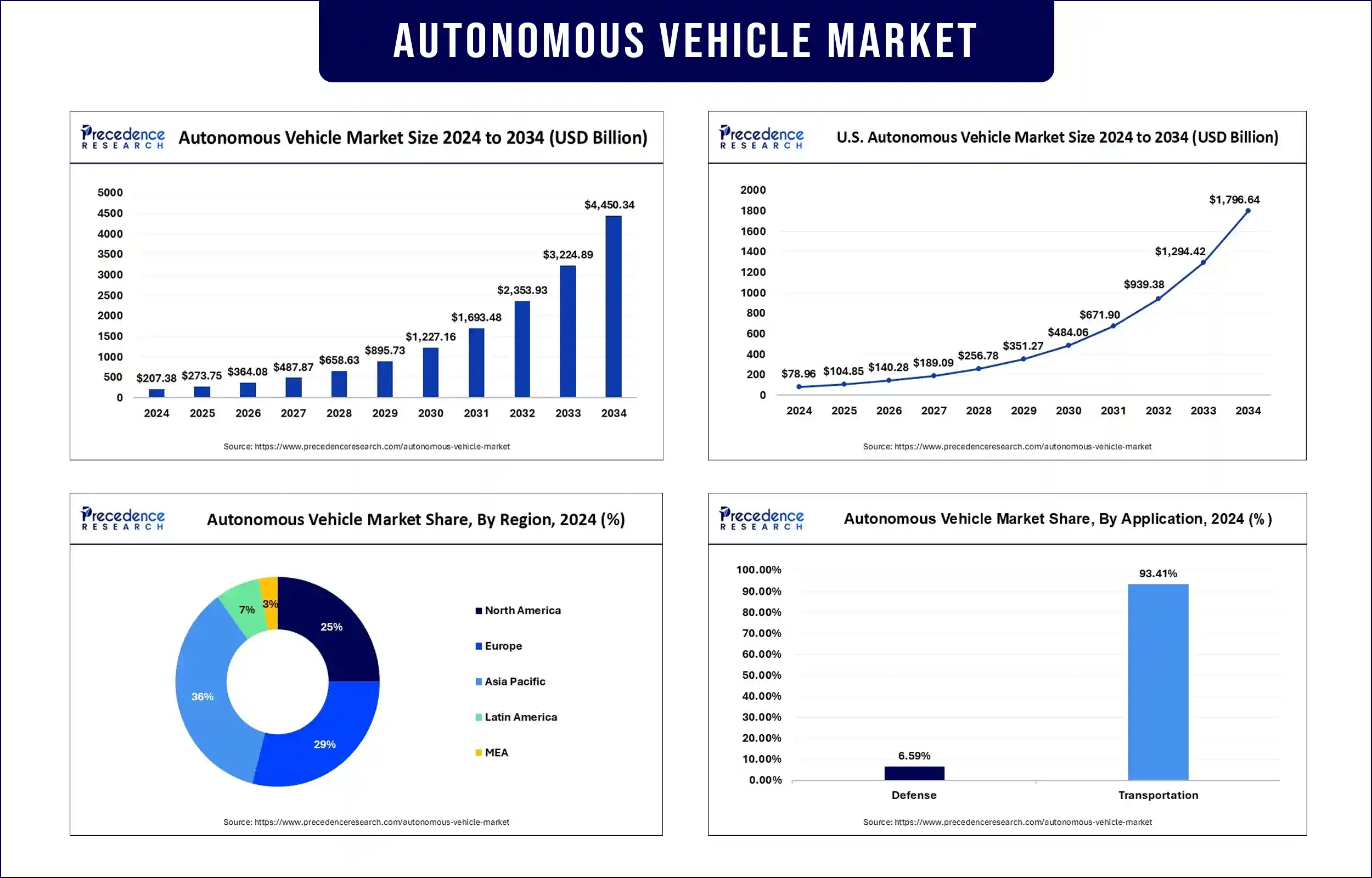December 2024
The global autonomous vehicle market revenue was valued at USD 273.75 billion in 2025 and is expected to attain around USD 3,224.89 billion by 2033, growing at a CAGR of 36.3% during forecast period. The market is driven by AI developments, safety innovations, and efficiency improvements.

An autonomous vehicle (AV) operates as a self-driving or driverless car through design that executes without requiring human-driver interaction. The vehicles contain sensor systems, cameras, radar, and artificial intelligence to operate without human operation. Self-driving vehicles have been developed to reach core objectives such as improved safety levels, increased efficiency, and better convenience in transportation.
The autonomous vehicle market grows because of improved sensors, AI capabilities, and connectivity, which produces an intelligent connected transportation system. The market continues to grow due to rising customer needs for speedier transportation, reducing traffic problems, and developing environmentally friendly mobility systems. Innovations within the market are promising because standard regulatory structures mate with increasing customer acceptance to transform the entire automotive industry.
Growth of Connected Infrastructure through Technological Innovation
The connected infrastructure expands due to technological advancements because it is essential for the autonomous vehicle market creation. The connection between sensors, machine learning, RADAR, and LiDAR systems with cameras creates more connected vehicles that develop better situational awareness and control functions.
Urbanization and the Need for Smarter Transportation Solutions
The urban development with increasing demands for enhanced transportation systems. Self-driving vehicles resolve essential urban problems such as air pollution and traffic jam congestion along with providing better parking options. Self-driving cars prove to be an effective transportation solution because they reduce road congestion, which improves efficiency.
Technological Advancements
Machine learning with AI technologies performs an on-the-spot evaluation of sensor data and camera information to produce full sphere perception. Vehicles operated by this technology examine road obstacles and pedestrians, which improves safety performance and better driving experiences.
Government Support and Investment
Several governments provide support to autonomous vehicle progress through designed regulatory systems and financial support. The U.S. Department of Transportation used USD 500 million from the SMART program to fund innovative transportation projects. The technology receives support from the initiative, which supports autonomous vehicles, roadside sensors, and aerial drones for advancing the industrial sector and enabling expansion in autonomous vehicle technology development.
North America’s leadership in the autonomous vehicle market is seen to be sustained in the upcoming years. The automotive industries in North America, specifically the United States, lead global advancements toward driverless car development. Leading technology businesses and research institutions specialize in artificial intelligence, sensors, and connectivity. Autonomous system development achieves optimal conditions in the California Silicon Valley through its advanced technological infrastructure.
The United States operates a successful automotive industry primarily through Tesla, General Motors, and Ford, which take the lead in autonomous vehicle research. The consumer acceptance drives regional demand for autonomous vehicles and other cutting-edge technologies, thus creating an innovative market that expands the demand for autonomous systems and drones.
European market for autonomous vehicles held a significant share in 2024 due to European nations creating supportive regulatory guidelines for integrating self-driving vehicles. The surge in connected car technology demands has become one key driving force behind vehicle tracking systems because these tools establish instant vehicle-to-structure and driver-to-vehicle data sharing processes in real-time.
Several automotive technology corporations based in Europe created advanced platforms which transformed IoT and telematics connectivity. The government shows strong dedication to autonomous vehicles through their targeted plans for converting all road vehicles into autonomous systems, which will create a new transportation paradigm.
| Report Attribute | Key Statistics |
| Market Revenue in 2025 | USD 273.75 Billion |
| Market Revenue by 2033 | USD 3,224.89 Billion |
| CAGR | 36.3% |
| Quantitative Units | Revenue in USD million/billion, Volume in units |
| Largest Market | North America |
| Base Year | 2024 |
| Regions Covered | North America, Europe, Asia-Pacific, Latin America, and Middle East & Africa |
BMW AG
Audi AG
Ford Motor Company
Daimler AG
Google LLC
General Motors Company
Nissan Motor Company
Honda Motor Co., Ltd.
Toyota Motor Corporation
Tesla
Volvo Car Corporation
Uber Technologies, Inc.
Volkswagen AG
By Application
By Level of Automation
By Propulsion Type
By Vehicle Type
Get this report to explore global market size, share, CAGR, and trends, featuring detailed segmental analysis and an insightful competitive landscape @ overviewhttps://www.precedenceresearch.com/sample/1074
You can place an order or ask any questions, please feel free to contact at sales@precedenceresearch.com|+1 804 441 9344
December 2024
January 2025
April 2025
January 2025